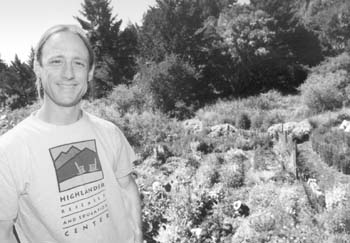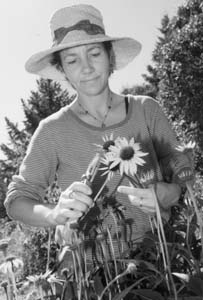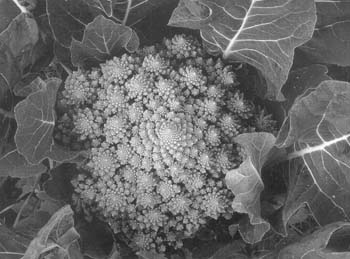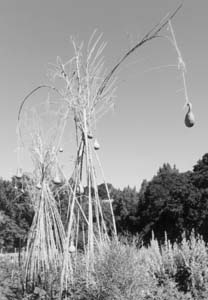![[MetroActive Features]](/gifs/feat468.gif)
[ Features Index | Sonoma County | MetroActive Central | Archives ]
The Art of Life
Nature's way: "Our strategy is to develop an educational research center that will allow us to ... make systemic changes in society rather than just responding to the latest crisis," says OAEC executive director Dave Hanson.
Occidental Arts & Ecology Center celebrates five years of sustainable living
By Paula Harris
RESIDENT GARDENER Kalanete Baruch looks relaxed and tanned as she strides along the grassy pathways in her short flowered dress, yellow straw hat, and black sandals. Taking occasional swigs of water from a large plastic container, she guides the way through the Occidental Arts and Ecology Center's impressive tangle of wildlands this hot Sunday morning. Baruch, 20-ish, is eager to begin the tour of this west county educational institute and so-called intentional community, which sits on 80 acres. Dreamy birdsong drifts down from the redwoods as we head for the south garden.
The gardens are beautiful in a casual, unkempt sort of way. No uniform rows, just great clumps of organic crops and flowers in shades of red, purple, orange, and white growing side by side like a vivid patchwork quilt. The earth is friable, soft, and lofty. It has been well worked into the beds and is irrigated by rainwater catchments.
There are abundant weeds, and small coppery tree frogs jump out from the undergrowth as Baruch strolls by. At night, she says, they strike up a wild chorus from the shallow ponds on the property.
She says the center harvests a huge variety of organic fruit and vegetable crops, including tomatoes, peppers, 25 varieties of garlic, squash, carrots, fennel, grapes, Asian pears, quince, and mulberries. There's even a rare medlar tree displaying its mushy, cinnamon-apple-flavored fruits.
We pass a wooden picnic table and a large oval bell suspended from a tree. "When the bell calls us, we come together for communal dinner," explains Baruch.
The meals are all vegetarian, prepared with the produce from the gardens.
Nestled amid high-forested ridges that once served as hunting grounds for Miwok and Pomo tribes, about 15 members of the center's community now live on the land and share cooking and chores. "That's my house," Baruch says proudly, pausing at a solitary wooden cabin located outside of the main gathering areas. The rustic structure is tiny, about 10 by 10 feet, with a bed-sized loft and two small solar-powered reading lamps. For the past several months, Baruch--who trades gardening tasks for food, board, and use of the center's facilities--has called it home while she participates in the OAEC's gardening program.
Since 1994, the center has been developing through the concentrated efforts by activists like Baruch interested in building and sustaining communities. Its programs run the gamut, from the practical (beekeeping and blacksmithing) to the political (rethinking democracy and the corporatization of public schools) to the esoteric (a course in naturalistic sight-size painting).
"We focus on trying to solve some of the root causes of environmental, social, and economic problems of the day," says OAEC executive director Dave Henson. "So many activists tend to deal with the symptoms. Our strategy is to develop an educational research center that will allow us to do the work to make systemic changes in society rather than just responding to the latest crisis."
Flower power: In search of a creative outlet, Tiona Gundy was drawn to the center's acclaimed gardening program.
AT THE HEART of the OAEC are six interlocking programs that define the center's philosophy of organic farming, ecological literacy, and protecting the healthy rural nature of the county:
* The Mother Garden Biodiversity Program aims to grow as many different plant types as possible, focusing on heirloom varieties and crops that are in danger of becoming extinct. There are three public plant sales each year that showcase biodiversity. "In a culture that's become so urbanized in the last 50 to 100 years, people have gone from agrarian to urban and lost contact with the earth and food and water cycles," says Henson. "We want to help our county remember and experience our relationship to earth and to food." As a backlash against chemical corporations like Monsanto, which purchases, files patents on, and controls much of the world's seed stock, OAEC is preserving the lost tradition of seed exchanges.
* The School-Garden Teacher Training Program's goal is to start gardens in all elementary schools in Sonoma County. Teachers can participate in a five-day residential workshop that shows how to create a curriculum based on gardening, including nutrition and ecological principles. "It's the antidote to an increasingly computer-based curriculum," says Henson.
* The Corporations and Democracy Program explains how large corporations are able to get the authority to control the world's food supply, and helps activists develop strategies they can incorporate to regain control. For example, the OAEC is set to launch a campaign in the county against genetically engineered food crops and genetically altered seeds.
* The Horticultural Therapy Program examines an emerging discipline that focuses on the healing and transformational powers of gardening on the body, mind, and spirit. The OAEC is now collaborating with Food for Thought, the local food bank for people with AIDS in Sonoma County, to create an organic, "healing" garden surrounding the food bank's new facility in Forestville. The goal is to grow a wide variety of fresh vegetables, flowers, herbs, and fruit, and to establish a place for gatherings, respite, celebration, and memorial.
* The Permaculture Program focuses on creating sustainable systems designs--such as natural building, beekeeping, and rain catchment--to create intricately connected and productive communities that are socially just, ecologically sustainable, and economically viable.
* The Arts Program is a fine arts course that emphasizes painting in the garden. "Here at the center, we keep our eyes and hearts rooted in artistic expression," says Henson.
THE OAEC'S UPCOMING fifth anniversary gala fundraiser also promises to be a work of art. The celebration (like such other pricey OAEC fundraising banquets, including the $100-$500 per plate Lost Crops of the Incas dinner) will boast a gourmet vegetarian feast with exotic seasonal crops from the center's gardens.
"We're celebrating that we've made it this far, " says Henson with a laugh.
Indeed, the property has a varied history. After a succession of family owners, the Farallones Institute purchased the land in 1974 for workshops in community development, appropriate technologies, passive-solar architecture, and bio-intensive organic gardening. The institute also ran a Peace Corps volunteer-training program funded by a U.S. government grant. The Farallones Institute ran out of steam in 1990 after the Reagan administration pulled the Peace Corps grant, its main source of income.
Then, the C.S. Fund in Freestone purchased the land and renamed the site Center for Seven Generations, focusing on biodiversity and food crops, and expanding the gardens.
In 1994, the current owners, a collective called the Sowing Circle (a nine-member group of biologists, artists, activists, educators, and horticulturists), purchased the property and founded the current center as a private non-profit organization. Henson, who is a member of the Sowing Circle, lives on the land with the other members.
"Our work as landowners is to steward the property and let the non-profit do its work and research," he explains.
BACK IN THE gardens, Baruch points out an even smaller cabin under a cluster of trees close to the main pond. It is home to Tiona Gundy, another work-trade gardener at the center. In March, she moved from a regular two-bedroom house in Tucson to this tiny wooden cabin, which actually is a small wagon. "We call it the gypsy wagon," Gundy says with a laugh. "It has no electricity or water, so I learned to get really simple."
A love of gardening and search for a creative outlet brought her to the OAEC, where she hopes to meet and network with other farmers and eventually get into the organic farming business and work with local chefs. "It's more important for me to be living on the land in a good community than to be isolated in a house in the city," says Gundy, 39. "I don't have a lot of stuff, but I'm a lot happier."
In the meantime, she says, she is becoming self-motivated and learning when to push herself and when to take a break in a job that's anything but 9 to 5. "It's a little community here: everyone pulls their weight to cultivate the gardens and keep the education center open," she says. "I feel like this land is being well taken care of."
[ Sonoma County | MetroActive Central | Archives ]
Copyright © Metro Publishing Inc. Maintained by Boulevards New Media.
![]()

Michael Amsler
 Michael Amsler
Michael Amsler

Michael Amsler
 Michael Amsler
Michael Amsler
The OAEC, at 15290 Coleman Valley Road in Occidental, celebrates its fifth anniversary on Saturday, July 31, with a festive gala. Tickets are $250-$500 (tables are available for $500-$5,000). The center also hosts garden volunteer days from 10 a.m. to 5 p.m. each Wednesday. Bring a vegetarian potluck lunch item to share. For details, call 874-1557.
From the July 15-21, 1999 issue of the Sonoma County Independent.